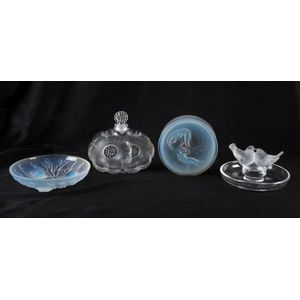In the Victorian era scent bottles were often made of pressed glass, with silver or silver-plate rims and cut glass or imitation cut glass stoppers.
Generally, the customer purchased the bottle empty and had it filled by a chemist or perfumier, as ready filled bottles of perfume were not yet on the market.
The variety of shapes was enormous. The larger scent bottles were made in the shape of flagons or decanters. In the 1870s a new design was produced: the double ended bottle. This was a slim cylindrical bottle with a round or polygonal surface. Some were produced
more...
in clear glass, some coloured dark blue, red, green, or yellow, and some were decorated in the Nailsea style. At each end were silver or plated caps, which were heavily chased or moulded. One half of the bottle was for scent and usually had a screw cap, while the other end was hinged, often spring loaded for fast access, and was for smelling salts.
Some bottles hinged in the middle, and when you opened them there was the grating of a vinaigrette on one side and on the other a recess with a glass-covered photograph. The outer ends had normal hinge- or screw-caps so that either part of the bottle could be filled with scent.
The production of scent bottles continued into the twentieth century, though it became more customary to buy scent in ready-filled bottles from cosmetic houses. These 'package' bottles in themselves have become the object of much decorative skill, and no doubt in the not-too-distant future they will be sought after by collectors.
Some manufacturers supplied scent bottles with rubber bulbs, which could be attached to the top of the bottle to produce a fine spray of scent. Although some types of scent bottle can be expensive, there are still many examples available at a reasonable price.
less...
The Sabino Maitre Verrier company (Sabino Master Glassmaker) was founded in Paris in 1919 by Sicilian born Marius Ernest Sabino. He grew up in France, and attended the L’Ecole Nationale Des Arts Decoratifs and Beaux Arts de Paris. His earlier production were metal chandeliers, mounted lamps and architectural accessories in moulded glass, and then after World War I he diversified into decorative objects in the Art Deco or Art Nouveau style, which he had designed.
It was in 1925 that first Sabino created the blue-hued semi-transparent opalescent glass for which the company is best known, and he
more...
expanded his business to make statuettes and figurines, both human and animal.
In the 1930s Sabino moved his production to his factory in Noisy-le-Sec in the south-eastern suburbs of Paris where production continued using the same techniques and moulds.
Limited production with the consent of the Germans continued during World War II, and when the war had finished, Sabino transferred the company's operations to his nephew and adopted son Gripoix Sabino, where production continued using the same moulds.
Marius Sabino died in 1961 and Gripoix Sabino continued production, still using the same techniques and moulds. Almost all the production was being exported to the United Sattes, and in 1978 the business was sold to Richard Choucroun, the company's American agent, trading as "Sabino Crystal Company".
The "Sabino Crystal Company" is based in Houston Texas and still selling the same blue-hued semi-transparent opalescent statues and decorative items that were were fist made in the late 1920s.
Earlier Sabino glass is usually signed "Sabino Paris", "Sabino France" or "Sabino", either in engraved cursive script, or if moulded, in uppercase. A catalogue raisonne of Sabino's work by Philippe Decelle, "Sabino - Catalogue Raisonne Sabino - Maitre Verrier D'l'Art Deco 1874-1961" was published in 1978.
less...










 Loading more...
Loading more...